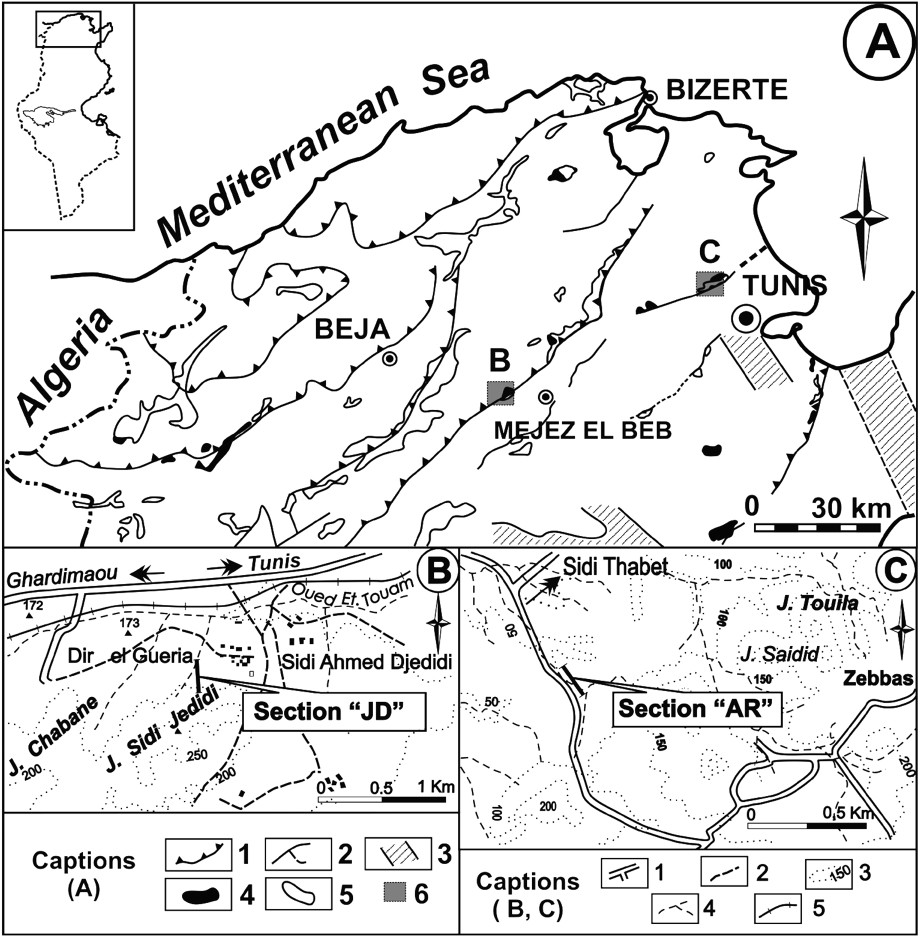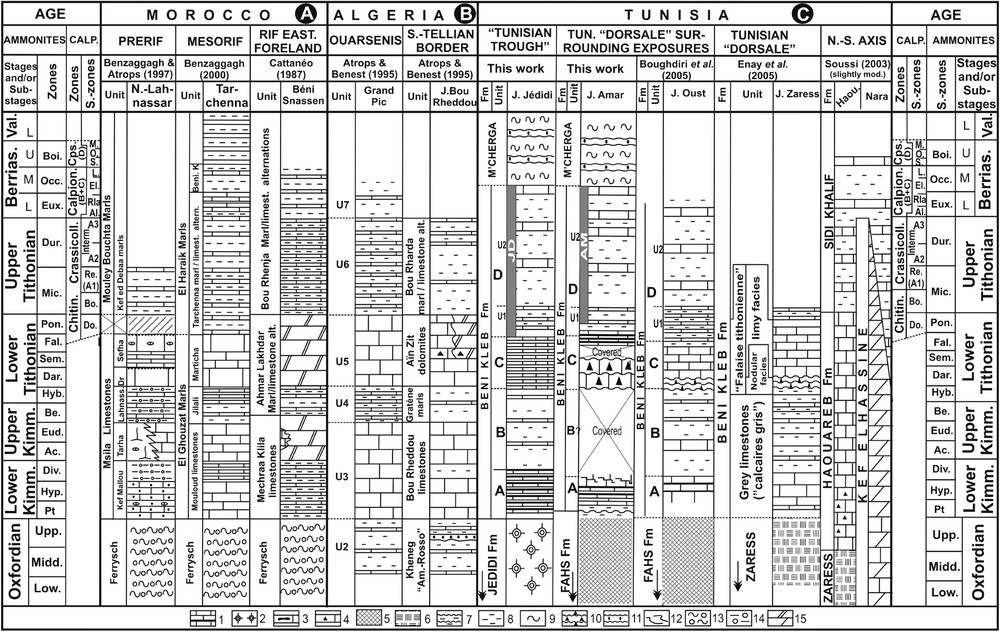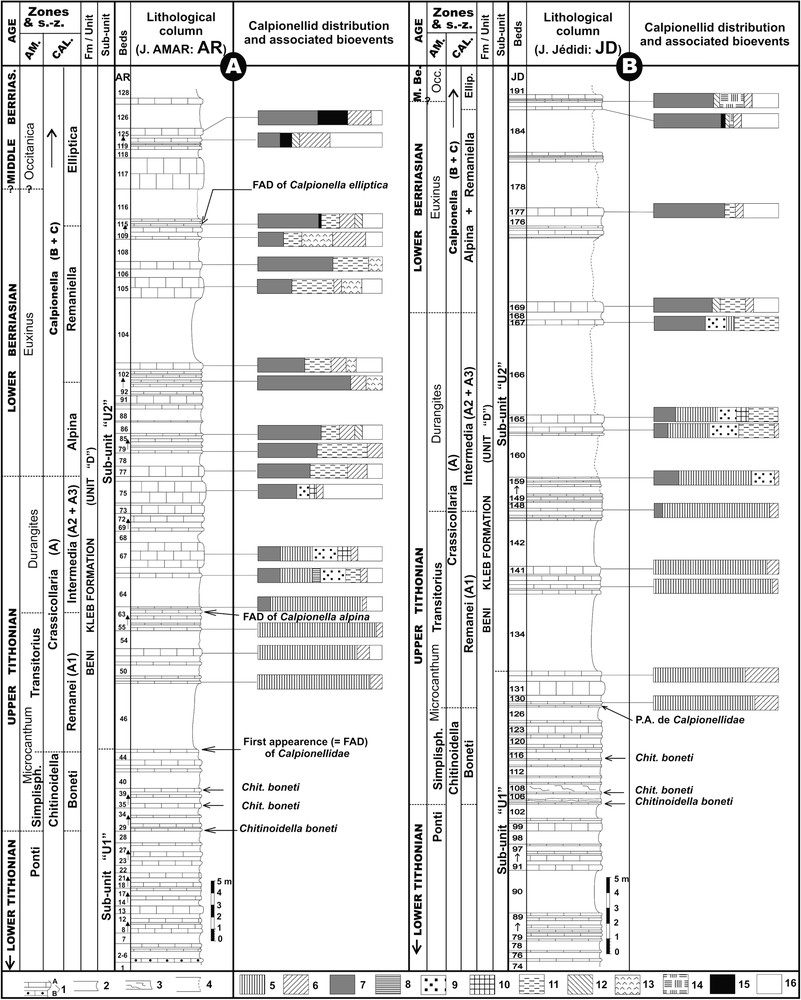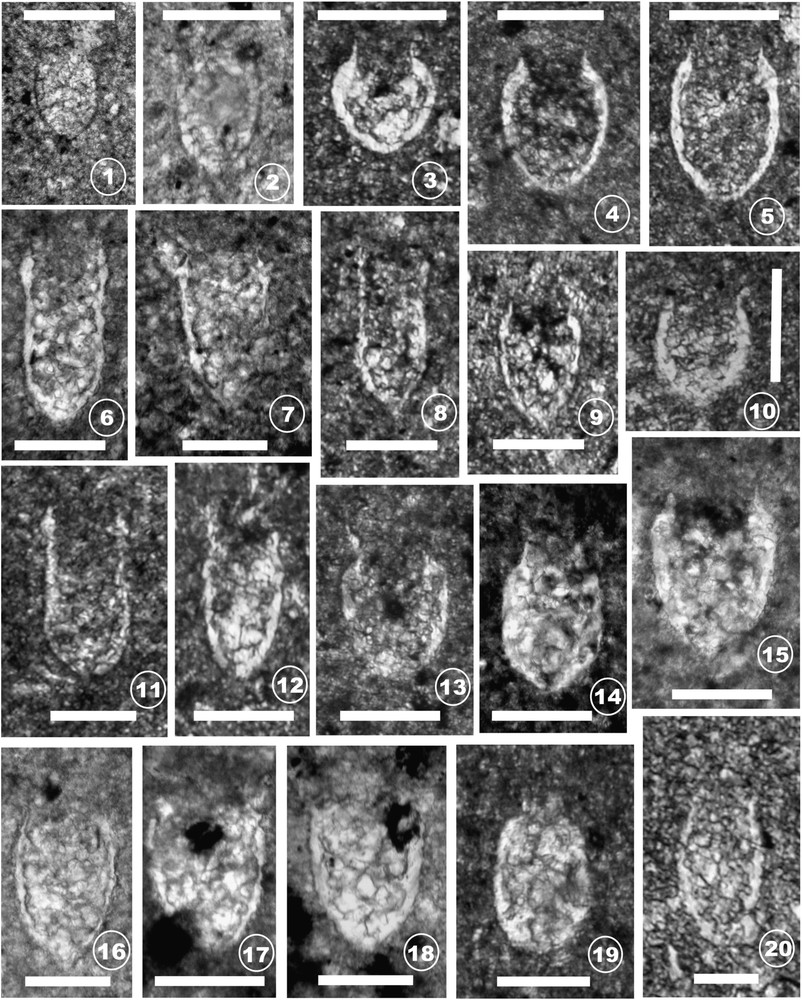1 Introduction
The Jurassic–Cretaceous transition formations Maiana, Hamada and Seroula [38] of North-Atlasic Tunisia had various stratigraphic attributions and controversial interpretations concerning their polarity (see synthesis in [49 (Fig. 2)]). The reversed stratigraphy of the series is demonstrated by [49], who consider their succession in the order Maiana–Hamada–Séroula, and attribute the respective ages as Upper Tithonian, Berriasian, and Valanginian–?Barremian. These often indirect age determinations are still vague or dubious. Calpionellid faunas were quoted by some authors (J. Amar, Ariana area [6,7,41,48,50]; Thuburnic, Ghardimaou area [34,56]; Jédidi–Chaâbane–Tamrhoura range, Mejez el Bab area [3,49,51]), but were never studied in detail. In this paper, we present biostratigraphic results based on calpionellids for the Upper Tithonian–Middle Berriasian interval from J. Amar (Ariana area) [49 (Fig. 1)] and J. Jédidi (Mejez El Beb) [48 (Fig. 2)] sections. In the light of the obtained data and considering recently published papers, new biochronological ages are attributed to the whole Upper Jurassic–Berriasian units identified in the ‘Tunisian Trough’ and a revised lithostratigraphy is proposed. Regional correlations and comparisons to the equivalent successions within the Maghrebides range replace these deposits in their West-Tethyan context.
2 Lithological successions
The J. Amar section of O. Ladhara was sampled 15 km to the northwest of Tunis and 4 km to the south of Sidi Thabet (Fig. 1C). As formulated by [48–50,58], but disagreeing with [1,6,19,38,41,57], we consider that the analysed successions belong to a reversed series. For this work, two successive major lithological groups characterize the Upper Jurassic–Lowermost Cretaceous series: a shaly radiolarian-bearing-limestone (‘faciès ocellés’ of Bonnefous [6] = Fahs Fm., Middle Callovian–Oxfordian [58]) and marl/limestone alternations that we include within the revised Béni Kleb Fm. [47]. The latter includes a limestone sequence (A) characterized by slumps at the base and, after a first covered interval, by turbidites corresponding to the ex. Maiana Fm. [38] non [48,49] (unit C, Fig. 3C). After a second covered interval, this unit is overlain by hemipelagic marl/limestone alternations (unit D) characterized by fine turbidites (Fig. 2A). This latter interval corresponds to the ex. Hamada Fm. [38]. Considering the variation of relative thicknesses of limestone beds and marly layers, two lithological sub-units (U1 and U2) can be distinguished (Fig. 2A and 3C).

Location of study areas. A: Northern Tunisia. 1: Thrust fault; 2: main fault; 3: trough; 4: Jurassic exposure; 5: Triassic exp.; 6: study area. B, C: Location of sections (B: J. Jédidi; C: J. Amar). 1: Highway; 2: gravel road; 3: elevation; 4: creek; 5: railway tracks.
Localisation des zones d'étude. A : Tunisie du Nord. 1 : Chevauchement ; 2 : faille majeure ; 3 : fossé ; 4 : affleurement jurassique ; 5 : aff. triasique ; 6 : zone d'étude. B, C : Localisation des coupes (B : J. Jédidi ; C : J. Amar). 1 : Route principale ; 2 : piste ; 3 : courbe de niveau ; 4 : ravin, oued ; 5 : chemin de fer.

Upper Jurassic–Lowermost Cretaceous series of North-Atlasic Tunisia: correlations within the external zones of the Maghrebides Range. 1: Limestone with or without thin marl layers; 2: radiolarian-bearing siliceous series (Fm. or ‘facies’ Jédidi); 3: limestone with chert nodules; 4: breccia (calcareous turbidite); 5: Fahs Fm. siliceous limestone and shales (‘faciès ocellé’); 6: red nodular limestone (Ammonitico Rosso); 7: marl/limestone alternations with slumps; 8: marls; 9: sandy marls and pelites of M'Cherga Fm.; 10: breccias, nodular limestone (débris flow deposits); 11: sandstone; 12: slumps; 13: shales and sandstones (ferrysch); 14: nodular marls; 15: dolomites. Masquer
Upper Jurassic–Lowermost Cretaceous series of North-Atlasic Tunisia: correlations within the external zones of the Maghrebides Range. 1: Limestone with or without thin marl layers; 2: radiolarian-bearing siliceous series (Fm. or ‘facies’ Jédidi); 3: limestone with chert nodules; 4: breccia (calcareous ... Lire la suite
Les séries du Jurassique supérieur–Crétacé basal de Tunisie nord-atlasique : corrélations avec leur homologues des zones externes des Maghrébides. 1 : Calcaire avec ou sans joints marneux ; 2 : série compréhensive à radiolaires (Fm. ou « faciès » Jédidi) ; 3 : calcaire à silex ; 4 : niveau bréchique (calciturbidites) ; 5 : « faciès ocellés» de la Fm. Fahs ; 6 : calcaire noduleux rouge (Ammonitico Rosso) ; 7 : alternance marno-calcaire à figures de glissement ; 8 : marnes ; 9 : pélites de la Fm. M'Cherga ; 10 : brèches, calcaires noduleux (« débris flow») ; 11 : grès ; 12 : niveau glissé ; 13 : argiles et grès (Ferrysch) ; 14 : marnes à nodules ; 15 : dolomie. Masquer
Les séries du Jurassique supérieur–Crétacé basal de Tunisie nord-atlasique : corrélations avec leur homologues des zones externes des Maghrébides. 1 : Calcaire avec ou sans joints marneux ; 2 : série compréhensive à radiolaires (Fm. ou « faciès » Jédidi) ... Lire la suite

Lithological succession, calpionellid assemblages and stratigraphy of studied sections (A: J. Amar AR; B: J. Jédidi JD). Lithology: 1A, limestone; 1B, calcareous turbidites; 2, marls; 3, slumps; 4, cover. Calpionellids. 5, Crassicollaria intermedia; 6, Tintinnopsella carpathica; 7, Calpionella alpina; 8, Cr. sp. gr. intermedia-massutiniana; 9, Cr. brevis; 10, Cr. massutiniana; 11, Cr. parvula; 12, Lorenziella gr. plicata; 13, Remaniella duranddelgai; 14, R. filipescui; 15, C. aff. elliptica; 16, Calpionellidae sp. indét. Masquer
Lithological succession, calpionellid assemblages and stratigraphy of studied sections (A: J. Amar AR; B: J. Jédidi JD). Lithology: 1A, limestone; 1B, calcareous turbidites; 2, marls; 3, slumps; 4, cover. Calpionellids. 5, Crassicollaria intermedia; 6, Tintinnopsella carpathica; 7, Lire la suite
Succession lithologique, répartition des calpionelles et stratigraphie des coupes (A : J. Amar AR ; B : J. Jédidi JD). Lithologie : 1A, calcaire ; 1B, turbidite calcaire ; 2, marnes ; 3, niveaux glissés ; 4, niveau tendre couvert. Calpionelles. 5, Crassicollaria intermedia ; 6, Tintinnopsella carpathica ; 7, Calpionella alpina ; 8, Cr. sp. gr. intermedia-massutiniana ; 9, Cr. brevis ; 10, Cr. massutiniana ; 11, Cr. parvula ; 12, Lorenziella gr. plicata ; 13, Remaniella duranddelgai ; 14, R. filipescui ; 15, C. aff. elliptica ; 16, Calpionellidae sp. indét. Masquer
Succession lithologique, répartition des calpionelles et stratigraphie des coupes (A : J. Amar AR ; B : J. Jédidi JD). Lithologie : 1A, calcaire ; 1B, turbidite calcaire ; 2, marnes ; 3, niveaux glissés ; 4, niveau tendre couvert. ... Lire la suite
The J. Jédidi section (Fig. 1B) starts with the first limestone bed overlying the radiolarian-bearing Jédidi Fm. (Upper Bajocian–Oxfordian [23,58,59]) = ‘radiolarites’ of [49] wrongly attributed to the Upper Kimmeridgian–Lower Tithonian interval). It comprises four successive units (Fig. 3C): limestone beds with intercalated marly layers (unit A), marl/limestone alternations with relatively thicker marly levels (unit B). These two units correspond to the lower part of Maiana Fm. of [48]. Follows another carbonate unit (C) and again a marl/limestone alternation (D) with chert nodules and rare turbidites, which corresponds to the upper part of Maiana Fm. of [48]. As for J. Amar, this calpionellid-bearing unit is composed of two sub-units U1 and U2, representing the major part of JD section (Fig. 2B and 3C).
3 Calpionellid distribution and biozonations (Fig. 4)

Calpionellids of the Tithonian–Berriasian transition. Mentions: taxon, layer, age (calpionellid zone and/or subzone; ammonite zone and/or subzone; substage), scale length 100 μm. 1–2: Chitinoidella boneti Doben, (1: JD107; 2: AR29), Chitinoidella zone, Boneti subzone; Microcanthum zone, Simplisphinctes subzone, Upper Tithonian; 3–5: Calpionella alpina Lorenz. 3: small variety, AR85, Calpionella zone, Alpina sub-zone, Euxinus zone, Lower Berriasian; 4: medium-sized variety, AR75, Crassicollaria zone, Intermedia subzone, Durangites zone, Upper Tithonian; 5: high variety, JD165, Crassicollaria zone, Intermedia subzone, Durangites zone, Upper Tithonian; 6: Crassicollaria aff. Massutiniana (Colom), AR65, Crassicollaria zone, Intermedia subzone, Durangites zone, Upper Tithonian; 7: Crassicollaria intermedia (Durand-Delga), JD141, Crassicollaria zone, Remanei subzone, Microcanthum zone, Transitorius subzone, Upper Tithonian; 8: Crassicollaria aff. intermedia, AR65, Crassicollaria zone, Intermedia subzone, Durangites zone, Upper Tithonian; 9: Crassicollaria brevis Remane, AR67, Crassicollaria zone, Intermedia subzone, Durangites zone, Upper Tithonian; 10: Tintinnopsella remanei Borza, JD137, Crassicollaria zone, Remanei subzone, Microcanthum zone, Transitorius subzone, Upper Tithonian; 11: Crassicollaria massutiniana, JD165, Crassicollaria zone, Intermedia subzone (lower A3), Durangites zone, Upper Tithonian; 12: Crassicollaria parvula Remane, AR69, Crassicollaria zone, Intermedia subzone (A3), Durangites zone, Upper Tithonian; 13: Lorenziella aff. plicata (Le Hégarat & Remane), AR85, Calpionella zone, Alpina subzone, Euxinus zone, Lower Berriasian; 14: Calpionella aff. elliptica Cadisch (short form), AR113, Calpionella zone, Alpina subzone, Euxinus zone, Lower Berriasian; 15: Crassicollaria gr. brevis, AR65, Crassicollaria zone, Intermedia (A2) subzone, Durangites zone, Upper Tithonian; 16: Tintinnopsella carpathica (Murgeanu & Filipescu), AR109, Calpionella zone, Remaniella subzone, Euxinus zone, upper Lower Berriasian; 17: Remaniella durandelgai Pop, AR105, Calpionella zone, Alpina subzone, Euxinus zone, upper Lower Berriasian; 18: Remaniella filipescui Pop, JD185, Calpionella zone, Alpina subzone, Euxinus zone, upper Lower Berriasian; 19: Calpionella aff. elliptica (deformed collar), AR125, Calpionella zone, Elliptica subzone, Occitanica zone, lower Middle Berriasian; 20: Tintinnopsella gr. carpathica, AR125, Calpionella zone, Elliptica subzone, Occitanica zone, lower Middle Berriasian. Masquer
Calpionellids of the Tithonian–Berriasian transition. Mentions: taxon, layer, age (calpionellid zone and/or subzone; ammonite zone and/or subzone; substage), scale length 100 μm. 1–2: Chitinoidella boneti Doben, (1: JD107; 2: AR29), Chitinoidella zone, Boneti subzone; Microcanthum zone, Simplisphinctes subzone, Upper ... Lire la suite
Reference biostratigraphic scale for ammonites is that proposed by [35]. For calpionellids, we used the standard of [55] and took into account recent data [36,37,46,52]. The biozonations established by [32] and [20] for the Tithonian–Lowermost Berriasian and by [39] for the Berriasian were also useful for correlation of ammonites and calpionellids. The first appearance (FAD) of Chitinoidella boneti within beds AR29 (J. Amar) and JD103 (J. Jédidi) marks the lower limit of the Boneti subzone (Chitinoidella zone) or the base of the ammonite Microcanthum zone and of its Simplisphinctes subzone (lowermost Upper Tithonian). FAD of true calpionellids within AR45 and JD127 draws the limit between Remanei [55] (= A1 [54]) and Boneti calpionellid subzones or that between the ammonite Simplisphinctes and Transitorius subzones (Microcanthum zone). Large varieties of Calpionella alpina appear within beds AR61 and JD147 below which we draw the transition between the Remanei (A1) and Intermedia (A2 + A3) calpionellid subzones that corresponds to the base of the ammonite Durangites zone. High relative frequencies of small C. alpina were recorded within beds AR77 and JD169 marking the limit between Crassicollaria (A) and the Calpionella (B + C [54]) calpionellid zones corresponding to the one between ammonite Durangites (Upper Tithonian) and Euxinus (Lower Berriasian) zones. A similar bioevent indicated the same biostratigraphic level for [49], but within another section of J. Amar (J. Touila) (see discussions below). The first Remaniella represented by R. durandelgai are recorded within AR97 below which the base of Remaniella subzone [46] (= Ferasini subzone [52]) can be drawn. At J. Jédidi, this limit could not be characterized by any index species. FAD of the index Calpionella elliptica within bed AR113 (J. Amar) locates the base of Elliptica calpionellid subzone [36,37,46,52] (= upper limit of Remaniella (= Ferasini) subzone), corresponding to a stratigraphic level close to the ammonite Occitanica zone of Middle Berriasian (Subalpina subzone). At J. Jédidi, this latter limit was identified by a calpionellid association within JD185 including Remaniella filipescui and rare forms related to C. elliptica together with the disappearance of Cr. parvula. The age we assign here to these higher levels agrees with [49] (Berriasian). However, our data show that the lower part of the unit included by these authors within the Berriasian is rather Lower Tithonian pars-Upper Tithonian in age.
4 Discussion and stratigraphic update
According to [48], Upper Jurassic–Berriasian successions at J. Amar (O. Ladhara) are composed of Zaress + Béni Kleb formations (Middle Callovian–Lower Tithonian), Maiana Fm. (Upper Tithonian) and Hamada Fm. (Berriasian), considering the base of Zaress + Béni Kleb as equivalent to a red nodular limestone layer (their Zaress Fm.) overlain by the Jédidi Fm. (‘radiolarites’). Soussi et al. [59] demonstrated that the Zaress Fm. of [32] is in fact the Kef El Orma Fm. (Aalenian–Lower Bajocian) and corresponds only to an Ammonitico Rosso-like facies. In addition, [49] reported calpionellids from zone A in the radiolarian-bearing micrites of their Maiana Fm. in the J. Touila section (J. Amar). Their regional correlations [48] conclude that their Hamada Fm. (Berriasian) is not present at J. Jédidi.
At the O. Ladhara section of J. Amar, Chitinoidella and true calpionellids are absent from the blue limestone beds which we consider as an equivalent of the Maiana Fm. [38]. The appearance of these faunas is recorded in the upper part of the hemipelagic overlying beds with sporadic turbiditic sequences at the base (= Hamada Fm. [38]). Thus, corresponding beds at J. Touila where [49] quoted calpionellids overlie true turbidites (= Maiana Fm.), which are not exposed at this locality, possibly cut by a fault identified at the base of the succession (see their Fig. 1, p. 1538).
Considering these biostratigraphic revisions, we conclude that: (1) the Béni Kleb Fm. overlies the Jédidi Fm. and cannot be considered its lateral equivalent; (2) the ex. Maiana (Lower Tithonian) and Hamada (upper Lower Tithonian–Middle Berriasian) formations cannot be considered as two units overlying the Béni Kleb Fm. (Lower Kimmeridgian–Middle Berriasian) and should be included within it; (3) at J. Jédidi, all Lower-to-lower Middle Berriasian zones and subzones are present and we have no palaeontological argument in favour of a Berriasian gap, as formulated by [48].
5 Regional correlations
In the J. Aziz section of northeastern Tunisia, Colom et al. [21] gave a Tithonian age for an upper limestone unit, yielding mostly C. elliptica and C. alpina. We consider this unit as upper Lower to lower Middle Berriasian in age. Quoted calpionellid taxa cannot be associated below this stratigraphic level (transition between B and C calpionellid zones). This attribution is reinforced by ammonites that [21] gathered within lower units: the index species ‘Virgatosphinctes’ (= Paraulacosphinctes) transitorius and Berriasella jacobi mark, respectively, the Upper Tithonian Microcanthum zone (Transitorius subzone) (= A1) and the Lowermost Berriasian Jacobi subzone (Euxinus zone) (= lower B). Concerning the O. Guelta section studied by the same authors, we agree with their Berriasian age assigned to lower limestone/marl alternations. We can precise that the quoted calpionellid species T. longa, ‘T.’ Cadischiana, C. alpina and C. elliptica indicate zone C [54] (= Longa zone [52] or Cadischiana zone [36,37]) of upper Middle Berriasian. Moreover, the small typical T. carpathica that gradually evolve to high narrow specimens [21, p. 528 and Fig. 9] do not exclude a Lower to lower Middle Berriasian age (lower calpionellid B zone) for the lower part of the studied beds.
In the same area, Combémorel et al. [22] established a precise calpionellid biostratigraphy for Jurassic/Cretaceous boundary deposits in different palaeogeographical subdomains. To their ‘pelagic facies’ (J. Boukornine of Hammam Lif, J. Oust, J. Béni Kleb, J. Zaress) or to those interpreted as indicating ‘transition to basin’ (J. Staa), they attribute an age spanning from the Lower Tithonian to the Middle Berriasian. This age, as well as tight facies affinities, makes the successions studied by [22] quite correlative with the calpionellid-bearing unit D of our work. It is worth noting that, in the southeastern part of the Tunisian ‘Dorsale’ platform, these facies are replaced by reefal to sub-reefal units of Upper Ressas Fm. [53], whose age can reach locally (Sidi Taia, Nymphée) the Upper Berriasian to the Valanginian.
Below calpionellid-bearing levels of such successions (Tunisian ‘Dorsale’), ammonite biostratigraphy proposed by [33] allows us to distinguish two informal units in the lower part of the Béni Kleb Fm.: lower marl/limestone alternations (Lower Kimmeridgian Platynota zone – Lowermost Tithonian Hybonotum zone) and a carbonate unit or ‘falaise tithonienne’ (Lower Tithonian pars). At J. Oust, Boughdiri et al. [9] provided the same ages to lithological units that can be easily correlated with those differentiated by [33] in the ‘Dorsale’ (Fig. 3C). As for J. Amar and Jédidi, the upper part of Béni Kleb Fm. at J. Oust (section JO.II of [9]) is upper Lower Tithonian (Ponti zone) to upper Lower Berriasian in age.
Complementary updated ammonite and calpionellid biostratigraphy of [33] and [9] allows us to differentiate four informal units within the Béni Kleb Fm.; each one of these units has similar facies within corresponding beds at J. Jédidi and J. Ammar. On the North–South Axis (NOSA) of central Tunisia, the Jurassic–Cretaceous transition is represented by the dolomites of the Kef El Hassine Fm. [58] (= upper Nara Fm. [12], partly equivalent to El Haouareb Fm. [43] amend. [58]) followed by marl/limestone alternations of Sidi Khalif Fm. [12]. Precise biostratigraphic data within Kef El Hassine Fm. are still lacking, but its base is attributed to the Lower Oxfordian [58] (= upper part of the underlying ammonite-bearing Zaress Fm.). For the Sidi Khalif Fm., Busnardo et al. [14,15] and M'rabet [42] proposed a precise biostratigraphy using ammonites and calpionellids. Within the northern part of the NOSA (J. Nara, J. Sidi Khalif), the studied calpionellid associations gave an age embracing the B, C and D zones of Remane [54] (i.e. Berriasian). Their ‘Upper Tithonian’ Jacobi zone is now considered as a subzone within the lowermost Berriasian Euxinus zone. Southward, in the J. Rhéouis section, the base of Sidi Khalif Fm. was first dated as upper Lower Tithonian by [14,15], using ammonites and calpionellids, [8] considered it as Upper Tithonian in age. In the southernmost part of the NOSA, ammonites and calpionellids studied by [13] indicate a Lower Tithonian age for the lower part of Sidi Khakif Fm.
Thus, the evidenced diachronous base of Sidi Khalif Fm. [14,15,28] is interpreted as due to deposition on tilted blocks. Considering ages assigned and facies affinities, the Kef El Hassine Fm. of Central Tunisia can be correlated with the carbonated units of Beni Kleb Fm. (Units A, B and C) of northern Tunisia (Fig. 3C). Although composed of more marly layers, Sidi Khalif Fm. can be considered as a lateral equivalent of the unit D of Béni Kleb Fm., as revised here.
6 Correlations within the Maghrebides and West-Tethyan setting
We present a synthesis of Kimmeridgian–Berriasian successions of North-Atlasic Tunisia and of equivalent series analysed by previous authors [2,4,5,16] in the Tello-Rifan external zones of Algeria and Morocco (Fig. 3). Lithological units are easily correlated with minor differences in age (local tectonic control). Among these successions, two major facies groups can be distinguished. From east to west, the first includes those from the Tunisian Dorsale and nearby exposures, to the South-Tellian border (Algeria) and to the internal Prerif and Mesorif successions. The second group includes the ‘Tunisian Trough’ series that are characterized by radiolarian-bearing series (Jédidi Fm.) at the base. In Algeria, to these successions correspond similar facies mentioned in the ancient literature in the Babors (e.g., [29,40,44], and references included) and in the West-Numidian Range [24,25].
These related series from the external domain are clearly different from coeval successions in the Maghrebian flysch zone and the innermost domain (Kabylo-Rifan Dorsale and ancient massifs). In the Rif, two important witnesses of the flyschs substratum consist of the ‘preflysch’ Tisirène Fm. [28] and the Ouareg unit of Targuist area [45]. They include calpionellid-bearing limestone units of Lower Berriasian and Upper Tithonian–Lower Berriasian ages, respectively. Similar successions with Middle Jurassic turbidites and Upper Jurassic radiolarites were also identified in the eastern Maghrebide Range as, in the Kabylias, the Achaiches series [10,26] and J. Abiod [60].
In a relatively inner structural setting, the Upper Jurassic series of the Kabylo-Rifan Dorsale located at the external limit of the ancient massifs are clearly different from the units correlated here. We can for instance mention particular facies often associated to true radiolarites, like those described in the Great Kabylia medium Dorsale [17] or on the western edge of the Rif internal domain: J. Moussa, Haouz Range ([27,30,31] and references therein).
Considering these examples, three major facies groups characterize the calpionellid-bearing series of these Maghrebian segments. The successions of the Tello-Rifan external zones can be connected to those of the ‘Tunisian Trough’ analysed here. All are different from the flyschs domain facies and opposed to coeval, more internal units of the Kabylo-Rifan Dorsale and ancient massifs. These affinities and differences confirm, on the one hand, the common geological history of the external segments of the African margin and, on the other hand, the distinct palaeogeographical evolution of the inner domain including the ‘dorsales calcaires’ and ancient massifs, both being separated by intermediate flyschs zone segments.
7 Conclusion
Calpionellid biozonation of the upper part of Béni Kleb Fm. from North-Atlasic Tunisia provides the first precise biostratigraphy for Upper Tithonian–Middle Berriasian series in J. Amar and J. Jédidi. It also gives an indirect age for the whole Upper Jurassic–Berriasian series of Béni Kleb Fm. within the ‘Tunisian Trough’. Compared to corresponding successions from the Maghrebides range, the Kimmeridgian–Berriasian series of North-Atlasic Tunisia show tight affinities with those from the internal Prerif and Mesorif (Morocco) and the South-Tellian border (Tiaret area, Algeria). Belonging to the external zones of the Maghrebides, all these facies are clearly opposed to their lateral equivalents from the Maghrebian flyschs domain and the innermost zones (Kabylo-Rifan Dorsale and ancient massifs). Replaced in their West-Tethyan geodynamic setting, we consider that elements of the Maghrebian inner zones were part of the Alkapeca microcontinent [11], which also included present-day Calabrese and Peloritan overthrusts. The western part of this microcontinent consisted of the Alboran terrane, which is a migrated element between the Africa and Iberia plates. During Upper Eocene–Oligocene times, the Alkapeca–Iberia collision generated back-thrust tectonics that evolved in a northwest-dipping subduction of the African margin beneath Alkapeca up to Miocene time [18]. During Tertiary Alpine s.l. general convergence, docking of the extending Alkapeca segments through the closure of the Maghrebian Flysch trough took place onto the African ancient margins that were formed by the present day Tello-Rifan external zones.
Acknowledgements
Raymond Enay (‘université Claude-Bernard, Lyon-1’, Lyons, France) and an anonymous reviewer provided constructive suggestions that thoroughly improved the original version of the paper.


